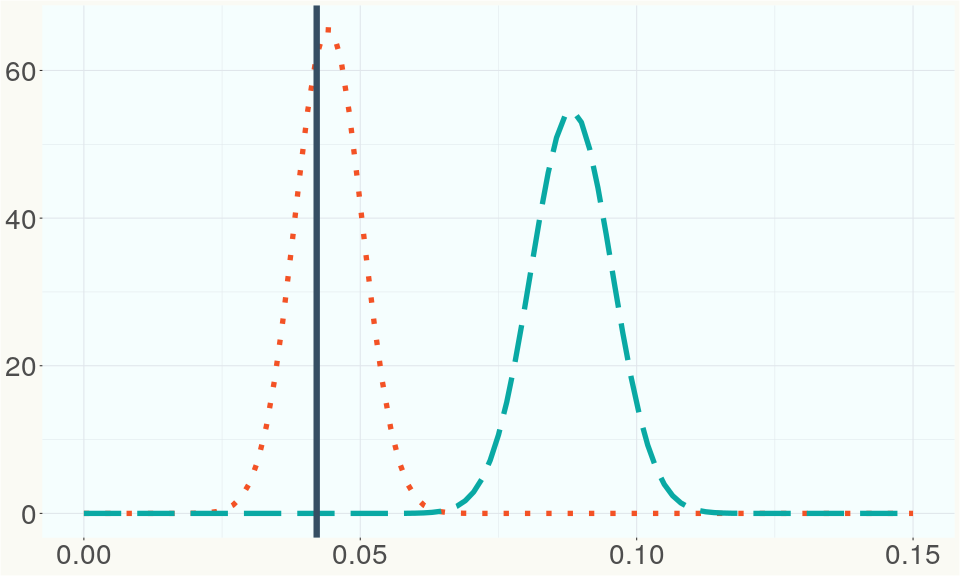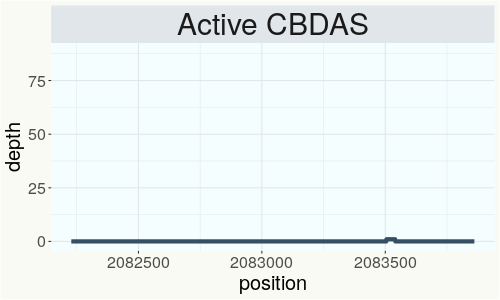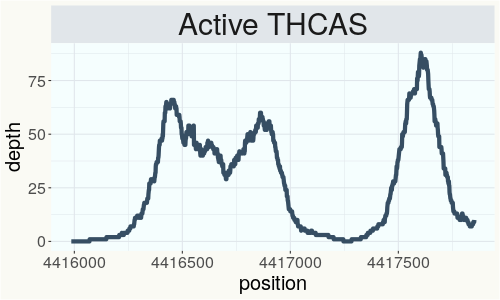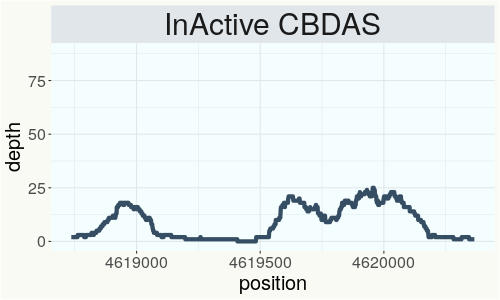RKM-2018-025
RSP 11117
Grower: R-Kiem Seeds
General Information
- Accession Date
- October 21, 2018
- Reported Plant Sex
- Female
- Report Type
- StrainSEEK v2 3.2Mb
- DNA Extracted From
- Stem
The strain rarity visualization shows how distant the strain is from the other cultivars in the Kannapedia database. The y-axis represents genetic distance, getting farther as you go up. The width of the visualization at any position along the y-axis shows how many strains there are in the database at that genetic distance. So, a common strain will have a more bottom-heavy shape, while uncommon and rare cultivars will have a visualization that is generally shifted towards the top.
Chemical Information
Cannabinoid and terpenoid information provided by the grower.
Cannabinoids
No information provided.
Terpenoids
No information provided.
Genetic Information
- Plant Type
- Type I
File Downloads
The bell curve in the heterozygosity visualization shows the distribution of heterozygosity levels for cannabis cultivars in the Kannapedia database. The green line shows where this particular strain fits within the distribution. Heterozygosity is associated with heterosis (aka hybrid vigor) but also leads to the production of more variable offspring. When plants have two genetically different parents, heterozygosity levels will be higher than if it has been inbred or backcrossed repeatedly.
The ratio of reads mapped to Y-contigs to reads mapped to the whole Cannabis genome (Y-ratios) has been demonstrated to be strongly correlated with plant sex typing. This plot shows the distribution of Y-ratios for all samples in our database which were sequenced with the same method (panel or WGS) as this sample and where this sample falls in the distribution.

This chart represents the Illumina sequence coverage over the Bt/Bd allele. These are the three regions in the cannabis genome that impact THCA, CBDA, CBGA production. Coverage over the Active CBDAS gene is highly correlated with Type II and Type III plants as described by Etienne de Meijer. Coverage over the THCA gene is highly correlated with Type I and Type II plants but is anti-correlated with Type III plants. Type I plants require coverage over the inactive CBDA loci and no coverage over the Active CBDA gene. Lack of coverage over the Active CBDA and Active THCA allele are presumed to be Type IV plants (CBGA dominant). While deletions of entire THCAS and CBDAS genes are the most common Bt:Bd alleles observed, it is possible to have plants with these genes where functional expression of the enzyme is disrupted by deactivating point mutations (Kojoma et al. 2006).



This chart represents the Illumina sequence coverage over the CBCA synthase gene.

Variants (THCAS, CBDAS, and CBCAS)
No variants to report
Variants (Select Genes of Interest)
| PKSG-2a | c.67T>A | p.Phe23Ile | missense variant | moderate | contig700 | 1945567 | A/T | |
| PKSG-2a | c.31A>T | p.Thr11Ser | missense variant | moderate | contig700 | 1945603 | T/A | |
| PKSG-2b | c.1152T>A | p.Asn384Lys | missense variant | moderate | contig700 | 1950486 | A/T | |
| PKSG-2b | c.1132C>G | p.Leu378Val | missense variant | moderate | contig700 | 1950506 | G/C |
|
| PKSG-2b | c.1117A>G | p.Ile373Val | missense variant | moderate | contig700 | 1950521 | T/C | |
| PKSG-2b | c.948T>G | p.Asp316Glu | missense variant | moderate | contig700 | 1950690 | A/C |
|
| PKSG-2b | c.945T>G | p.Ser315Arg | missense variant | moderate | contig700 | 1950693 | A/C |
|
| PKSG-2b | c.944G>A | p.Ser315Asn | missense variant | moderate | contig700 | 1950694 | C/T |
|
| PKSG-2b | c.934C>G | p.His312Asp | missense variant | moderate | contig700 | 1950704 | G/C |
|
| PKSG-2b | c.31A>T | p.Thr11Ser | missense variant | moderate | contig700 | 1951851 | T/A | |
| PKSG-2b | c.-2_1dupATA | start lost & conservative inframe insertion | high | contig700 | 1951880 | A/ATAT |
|
|
| PKSG-4b | c.496A>G | p.Lys166Glu | missense variant | moderate | contig700 | 2721177 | T/C | |
| PKSG-4b | c.489delT | p.Phe163fs | frameshift variant | high | contig700 | 2721183 | CA/C | |
| PKSG-4b | c.485A>G | p.Lys162Arg | missense variant | moderate | contig700 | 2721188 | T/C | |
| PKSG-4b | c.431T>G | p.Val144Gly | missense variant | moderate | contig700 | 2721242 | A/C | |
| PKSG-4b | c.419A>G | p.Asp140Gly | missense variant | moderate | contig700 | 2721254 | T/C | |
| PKSG-4b |
c.352_355del |
p.Thr118fs | frameshift variant | high | contig700 | 2721317 | CCTGT/C |
|
| aPT4 | c.775delT | p.Tyr259fs | frameshift variant | high | contig121 | 2831380 | AT/A |
|
| aPT1 | c.406A>G | p.Ile136Val | missense variant | moderate | contig121 | 2839605 | A/G | |
| aPT1 | c.629C>T | p.Thr210Ile | missense variant | moderate | contig121 | 2840237 | C/T | |
| HDS-2 |
c.82_93delGT |
p.Val28_Thr3 |
conservative inframe deletion | moderate | contig95 | 1989748 |
CGTAACCGGAAC |
|
| HDS-2 | c.127T>G | p.Ser43Ala | missense variant | moderate | contig95 | 1989794 | T/G |
|
Nearest genetic relatives (All Samples)
- 0.000 RKM-2018-016 (RSP11108)
- 0.000 BLACK JACK (RSP11346)
- 0.003 Black Jack (RSP10603)
- 0.033 RKM-2018-027 (RSP11119)
- 0.140 Durban Poison #1 (RSP11013)
- 0.141 Durban Poison #1 (RSP10996)
- 0.145 Saint Jack (RSP11179)
- 0.147 Durban Poison (RSP10998)
- 0.150 Durban Poison (RSP11014)
- 0.158 Gold Cracker (RSP11048)
- 0.158 Gold Cracker (RSP11041)
- 0.163 Cheese (RSP10460)
- 0.166 Durban Poison (RSP11226)
- 0.172 Tangerine Haze (RSP10995)
- 0.177 Blue Dream (RSP11007)
- 0.179 White Label 1 (RSP11336)
- 0.181 UP Sunrise (RSP10989)
- 0.183 Lift (RSP11378)
- 0.185 Electra (RSP11366)
- 0.186 Super Lemon Haze (RSP11641)
Most genetically distant strains (All Samples)
- 0.454 Cherry Blossom (RSP11323)
- 0.421 Cherry Blossom (RSP11328)
- 0.417 Cherry Blossom (RSP11311)
- 0.413 Cherry Blossom (RSP11309)
- 0.408 CS (RSP11208)
- 0.407 Cherry Blossom (RSP11298)
- 0.405 Cherry Blossom (RSP11314)
- 0.402 Feral (RSP11205)
- 0.398 Carmaleonte (RSP11207)
- 0.396 Cherry Blossom (RSP11312)
- 0.394 Feral (RSP11206)
- 0.394 80E (RSP11213)
- 0.393 R1in136 (SRR14708227)
- 0.390 Cherry Blossom (RSP11334)
- 0.390 Feral (RSP10890)
- 0.390 Cherry Blossom (RSP11317)
- 0.389 Fatso (RSP11741)
- 0.389 R1in136 (SRR14708226)
- 0.387 Cherry Blossom (RSP11318)
- 0.386 Feral (RSP10891)
Nearest genetic relative in Phylos dataset
- Overlapping SNPs:
- 89
- Concordance:
- 84
Nearest genetic relative in Lynch dataset
- Overlapping SNPs:
- 13
- Concordance:
- 13
Blockchain Registration Information
- Transaction ID
-
dd6df4065ca44f7f
feb0d8084fd517cf 645b84abbc30e4e4 300e27a75518fae9 - Stamping Certificate
- Download PDF (839.3 KB)
- SHASUM Hash
-
0b6239dcb4bd16af35baf462ae5334b1 c7b0ddfa6c18706a 9c674c148f1168a9